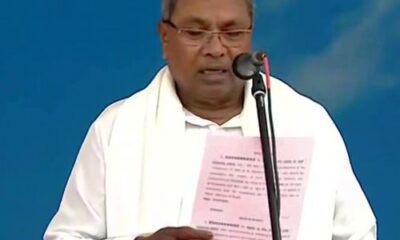Space
GSAT-24, India’s recent communication satellite, launched successfully

On Thursday, French company Arianespace successfully launched the GSAT-24 satellite from Kourou in French Guiana (South America), which was constructed by ISRO for NewSpace India Limited (NSIL).
GSAT-24 is a 4180 kg 24-Ku band communication satellite that provides pan-India coverage for DTH application requirements.
It was NSIL’s first “demand driven” communication satellite mission following reforms to the space industry.
Tata Play holds a lease on the entire satellite capacity from NSIL, a government-owned organisation under the Department of Space.
GSAT-24 was launched from the Guiana Space Centre, Europe’s spaceport in Kourou, on Ariane-V VA257.
Space
NASA spacecraft spots Moon crater likely caused by Russia’s Luna 25
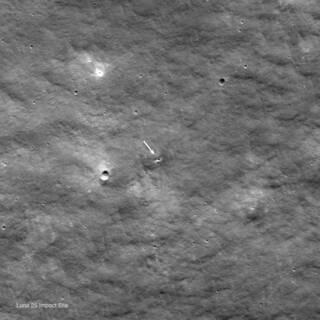
Washington, Sep 1 (IANS) US space agency NASA on Friday said that its Lunar Reconnaissance Orbiter (LRO) spacecraft has imaged a new crater on the Moon’s surface that is likely the impact site of Russia’s Luna 25 mission.
Luna-25, which took off atop a Soyuz-2.1b rocket from the Vostochny launch facility in Russia at 2.10 a.m. Moscow time (4.40 a.m. IST) on August 11, TASS news agency reported.
Russia’s Luna Lander mission, which launched on August 11 was expected to be on the Moon’s South Pole along with India’s Chandrayaan-3. However, during its descent, Luna 25 experienced an anomaly that caused it to impact the surface of the Moon on August 19.
Roscosmos, Russia’s space agency, published an estimate of the impact point on August 21.
LRO’s most recent “before” image of the area was captured in June 2022; thus, the new crater formed sometime after that date. Since this new crater is close to the Luna 25 estimated impact point, the LRO team concludes it is likely to be from that mission, rather than a natural impactor.
“The new crater is about 10 metres in diameter and is located at 57.865 degrees south latitude and 61.360 degrees east longitude at an elevation of about minus 360 metres,” NASA said.
“The impact point was on the steep (greater than 20-degree grade) inner rim of Pontecoulant G crater, about 400 kilometres short of Luna 25’s intended landing point at 69.545 degrees south, 43.544 degrees east,” it added.
Russia aimed to return to the Moon with its Luna 25 lander mission after 47 years. Its last lunar mission, Luna-24 was launched in 1976, during the former Soviet Union period.
Meanwhile, Roscosmos has planned Luna-26 for 2027 and Luna-27 for 2028, Luna-28 in 2030 or later. The country is also aiming at a manned mission and the construction of a lunar base, along with other countries such as the US, India and China.
Space
Countdown for India’s rocket mission to the Sun begins at 12.20 pm
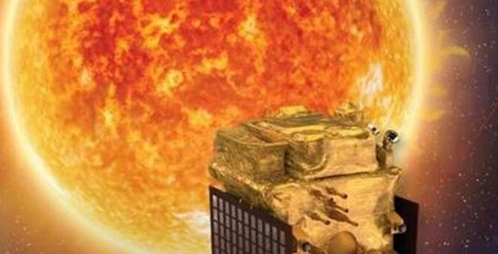
Chennai, Sep 1 (IANS) The countdown for the Saturday morning launch of India’s third interplanetary mission — this time to the Sun – Aditya-L1 — will begin at 12.20 p.m. on Friday, said a senior official of Indian Space Research Organisation (ISRO).
“The countdown will begin at 12.20 p.m. today (Friday),” the official told IANS.
Interestingly, India on August 23 reached the Moon with its lander safely landing on the lunar soil in a textbook style. Later the rover rolled down and started doing experiments.
The Aditya-L1 — named after the Sun God in Hindu mythology — will be carried by the Indian rocket Polar Satellite Launch Vehicle-XL variant (PSLV-XL). On Saturday, the rocket will blast off at 11.50 a.m. from the Sriharikota rocket port in Andhra Pradesh, the ISRO said.
During the countdown process, the fuelling of the rocket — liquid fuel — will be done as well as checking of its systems.
Initially, Aditya-L1 will be ejected in a low earth orbit (LEO). Then the orbit will be elliptical. As the spacecraft travels towards L1, it will exit the earth’s gravitational Sphere of Influence (SOI).
After exit from SOI, the cruise phase will start and subsequently the spacecraft will be injected into a large halo orbit around the Lagrange Point (L1) — the point where the gravitational pull of two large bodies will be equal and hence the spacecraft will not gravitate towards any one of the planet.
The total travel time from launch to L1 would take about four months for Aditya-L1 and the distance will be about 1.5 million km from the Earth.
The distance between the Earth and the Moon is about 3,84,000 km.
“A satellite placed in the halo orbit around the L1 point has the major advantage of continuously viewing the Sun without any occultation/eclipses.
This will provide a greater advantage of observing the solar activities and its effect on space weather in real time,” the ISRO said.
According to the ISRO, the spacecraft carries seven payloads to observe the photosphere, chromosphere, and the outermost layers of the Sun (the corona) using electromagnetic and particle and magnetic field detectors.
“Using the special vantage point L1, four payloads directly view the Sun and the remaining three payloads carry out in-situ studies of particles and fields at the Lagrange point L1, thus providing important scientific studies of the propagatory effect of solar dynamics in the interplanetary medium,” it said.
Aditya-L1’s seven payloads are expected to provide the most crucial information to understand the problem of coronal heating, coronal mass ejection, pre-flare and flare activities and their characteristics, dynamics of space weather, propagation of particle and fields and others, the Indian space agency said.
The ISRO said the major science objectives of Aditya-L1 mission are: Study of solar upper atmospheric (chromosphere and corona) dynamics, study of chromospheric and coronal heating, physics of the partially ionised plasma, and initiation of the coronal mass ejections, and flares.
It will also observe the in-situ particle and plasma environment providing data for the study of particle dynamics from the Sun.
Other objectives are physics of solar corona and its heating mechanism, the diagnostics of the coronal and coronal loops plasma: Temperature, velocity and density, development, dynamics and origin of Coronal Mass Ejections (CME), to identify the sequence of processes that occur at multiple layers (chromosphere, base and extended corona) which eventually leads to solar eruptive events, magnetic field topology and magnetic field measurements in the solar corona, and the drivers for space weather (origin, composition and dynamics of solar wind).
The Indian space agency said that the Sun estimated to be 4.5 billion years old is a hot glowing ball of hydrogen and helium gases and is the source of energy for the solar system. “The gravity of the sun holds all the objects of the solar system together. At the central region of the sun, known as ‘core’, the temperature can reach as high as 15 million degree Celsius,” it said.
At this temperature, a process called nuclear fusion takes place in the core which powers the Sun. The visible surface of the sun known as photosphere is relatively cool and has a temperature of about 5,500 degree Celsius, the ISRO said.
The sun is the nearest star and therefore can be studied in much more detail as compared to other stars. By studying the sun, we can learn much more about stars in our Milky Way as well as about stars in various other galaxies, the ISRO said.
The Sun is a very dynamic star that extends much beyond what we see. It shows several eruptive phenomena and releases immense amount of energy in the solar system. If such explosive solar phenomena is directed towards the earth, it could cause various types of disturbances in the near earth space environment.
Various spacecraft and communication systems are prone to such disturbances and therefore an early warning of such events is important for taking corrective measures beforehand.
In addition to these, if an astronaut is directly exposed to such explosive phenomena, he/she would be in danger. The various thermal and magnetic phenomena on the sun are of extreme nature. Thus, the Sun also provides a good natural laboratory to understand those phenomena which cannot be directly studied in the lab.
The Indians space agency said all the seven payloads carried by Aditya-L1 are indigenously developed by different laboratories in the country in close coordination with it.
The Visible Emission Line Coronagraph (VELC) instrument is developed at the Indian Institute of Astrophysics, Bangalore; Solar Ultra-violet Imaging Telescope (SUIT) instrument at Inter University Centre for Astronomy & Astrophysics, Pune; Aditya Solar wind Particle Experiment (ASPEX) at Physical Research Laboratory, Ahmedabad; Plasma Analyser Package for Aditya (PAPA) at Space Physics Laboratory, Vikram Sarabhai Space Centre, Thiruvananthapuram; Solar Low Energy X-ray Spectrometer (SoLEXS) and High Energy L1 Orbiting X-ray Spectrometer (HEL1OS) payloads at U R Rao Satellite Centre, Bangalore and the Magnetometer at the Laboratory for Electro Optics Systems, Bengaluru.
Space
ISRO scientists offer prayers at Tirumala ahead of Aditya L1 launch
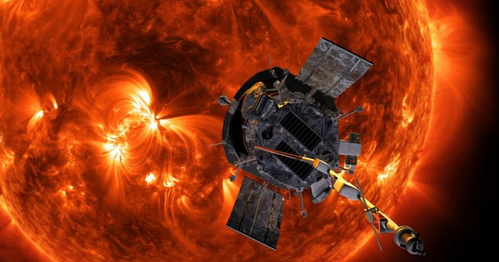
Tirupati, Sep 1 (IANS) Ahead of the crucial launch of Aditya L1 mission, aimed at studying the Sun, scientists of the Indian Space Research Organisation (ISRO) offered prayers at Tirumala temple here on Friday
The scientists from the space agency visited Sri Venkateswara temple atop Tirumala Hills in the morning.
They prayed for the success of the mission, which is scheduled to be launched on September 2 at 11.50 a.m. from the Sriharikota spaceport in Andhra Pradesh.
Aditya L1 spacecraft is designed for providing remote observations of the solar corona and in situ observations of the solar wind at L1 (Sun-Earth Lagrangian point), which is about 1.5 million kilometres from the earth.
The first space-based Indian observatory to study the Sun would be launched by PSLV-C57 rocket.
It’s a common practice for the ISRO scientists to offer prayers at the famous hill shrine ahead of major missions.
In July, they performed puja at the temple ahead of the launch of Chandrayaan-3.
The Moon mission scripted history by successfully landing on the lunar surface on August 23. India became the only country to accomplish soft landing on the Moon’s South Pole.
Space
ISRO Chairman offers prayers for success of Aditya L1
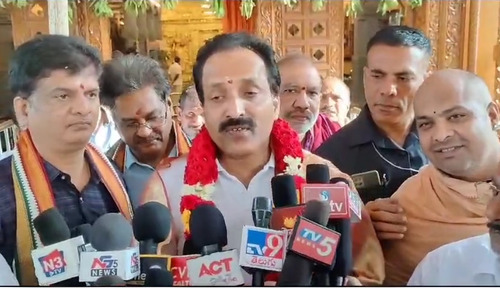
Tirupati (Andhra Pradesh), Sep 1 (IANS) The Chairman of Indian Space Research Organisation (ISRO), S. Somanath, on Friday offered prayers at a temple near the Satish Dhawan Space Centre, Sriharikota, for the success of India’s rocket mission to the Sun.
Ahead of the crucial launch of the Aditya L1 mission scheduled on Saturday, aimed at studying the Sun, Somanath offered prayers at the Chengalamma Parameshwari temple near the spaceport.
“I came here to pray to Chengalamma Parameshwari for giving us strength to make this launch successful,” he told reporters after offering prayers.
Earlier, a group of ISRO scientists had offered prayers at the Tirumala temple on Friday morning.
Somanath said the countdown has started for the PSLV-C57 Aditya-L1 mission, which will be launched at 11.50 a.m. on Saturday.
“It will take almost an hour for the satellite to reach the required location and inject. The Aditya L1 mission is to study the Sun. It will take another 125 days to travel from Earth to the L1 point from where the satellite will look at the Sun,” he said.
Replying to another query, the ISRO chief said the date for Chandrayaan-4 has not been decided yet.
“We will announce soon. Something is there,” he said with a smile.
On the Chandrayaan-3 mission, Somanath said that lunar rover Pragyan is working very well, moving around the Moon and doing rotations which will go on till September 3.
Earlier, some scientists from the space agency visited the Sri Venkateswara temple atop Tirumala hills on Friday morning and prayed for the success of the Aditya L1 mission .
The Aditya-L1 spacecraft is designed for providing remote observations of the solar corona and in situ observations of the solar wind at L1 (Sun-Earth Lagrangian point), which is about 1.5 million km from the Earth.
The first space-based Indian observatory to study the Sun would be launched by a PSLV-C57 rocket.
It’s a common practice for the ISRO scientists to offer prayers at the famous hill shrine ahead of major missions.
In July, they had performed ‘puja’ at the temple with a miniature model of Chandrayaan-3.
The Moon mission scripted history by successfully landing on the lunar surface on August 23, as India became the only country to accomplish soft landing on the Moon’s South Pole.
Space
NASA prepares for delivery of asteroid sample by OSIRIS-REx in Sept

Washington, Aug 31 (IANS) A team of NASA scientists is in the final stages of preparing for the arrival of the first US asteroid sample — slated to land on Earth in September on OSIRIS-REx spacecraft.
OSIRIS-REx (Origins, Spectral Interpretation, Resource Identification, and Security–Regolith Explorer), the first US mission to collect a sample from an asteroid, will return to Earth on September 24 with material from asteroid Bennu. It is carrying an estimated 8.8 ounces of rocky material collected from the surface of the asteroid Bennu in 2020.
A mockup of an OSIRIS-REx sample capsule was dropped on Wednesday from an aircraft and landed at the drop zone at the Department of Defense’s Utah Test and Training Range in the desert outside Salt Lake City. This was part of the mission’s final major test prior to the arrival of the actual capsule.
“We are now mere weeks away from receiving a piece of solar system history on Earth, and this successful drop test ensures we’re ready,” said Nicola Fox, associate administrator of NASA’s Science Mission Directorate in Washington, in a statement.
“Pristine material from asteroid Bennu will help shed light on the formation of our solar system 4.5 billion years ago, and perhaps even on how life on Earth began,”Fox added.
This drop test follows a series of earlier rehearsals — capsule recovery, spacecraft engineering operations, and sample curation procedures — conducted earlier this spring and summer.
Now, with less than four weeks until the spacecraft’s arrival, the OSIRIS-REx team is nearing the end of rehearsals and ready for the actual delivery.
The asteroid sample will help researchers to learn about how our planet and solar system formed, as well as the origin of organics that may have led to life on Earth.
Travelling about 27,650 mph, OSIRIS-REx is expected to enter Earth’s atmosphere at 10:42 a.m. EDT (8:12 pm IST) on September 24.
“We are now in the final leg of this seven-year journey, and it feels very much like the last few miles of a marathon, with a confluence of emotions like pride and joy coexisting with a determined focus to complete the race well,” said Rich Burns, project manager for OSIRIS-REx at NASA’s Goddard Space Flight Center in Greenbelt, Maryland.
Once retrieved, the sample will be documented, cared for, at NASA’s Johnson Space Center in Houston, and later distributed for analysis to scientists worldwide.
-
Video2 years ago
PM Modi Attacks Congress in Karnataka with “Kerala Story”
-
Politics2 years ago
Siddaramaiah & DK Shivakumar sworn in as Chief Minister & Deputy CM respectively
-
Cricket2 years ago
CSK players rejoice 5th IPL title with their families (Pics)
-
Entertainment1 year ago
Karan Deol weds his longtime Girlfriend Drisha Acharya (Pics)
-
Entertainment2 years ago
Urvashi Rautela dazzles on Cannes 2023 red carpet (Pics)
-
Sports7 years ago
History Of Official FIFA WORLD CUP Match balls
-
Entertainment2 years ago
Sunny Leone gets ready for Kennedy premiere in Cannes (Pics)
-
India2 years ago
Ashwini Vaishnaw: Railway Board recommends CBI probe in the Odisha railway disaster














